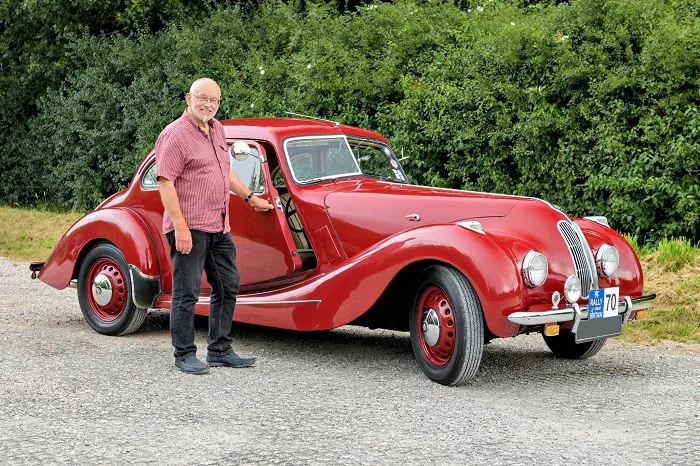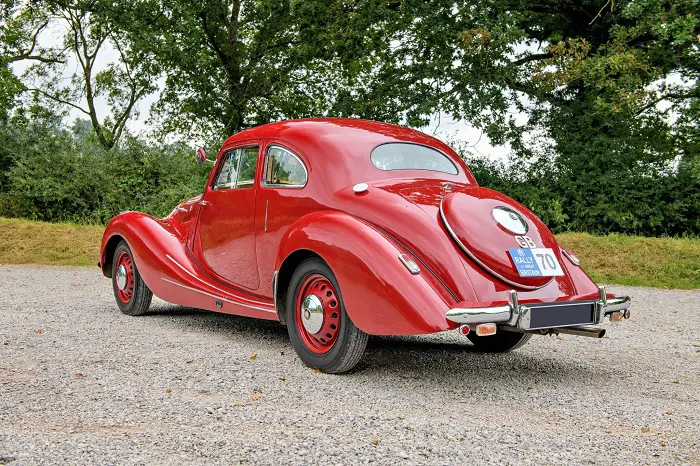MEET THE OWNER – FIL BAKER AND HIS BRISTOL 400
12 November 2024
“I first saw one of these magnificent cars at a rally, of sorts, in the early or mid-1970s, and promised myself on the spot that I’d have one. Fast forward to October 2022, and whilst casually browsing an online auction (always a bad idea!), I came across this one. A note came up, to say that the reserve had just been lowered, so I put in a tentative bid and found that my bluff had been called - I’d won it, sight unseen.”

And ‘magnificent’ is the only word for Fil Baker’s 1948 example. Three years earlier, to quote the automotive historian Jonathan Wood, “the Bristol Aeroplane Company decided to enter the automobile market and produce a car ‘hand-built for the connoisseur’ made to aircraft quality standards of materials and inspection”. George White, the company’s joint MD, believed the BMW 327/80 coupe was the sort of vehicle Bristol should be producing.
By 1934, AFN Ltd. (Archie Frazer-Nash) began importing BMWs for the UK market. In July 1945, Bristol took a majority shareholding in the firm. That year, its Managing Director, H.J. Aldington, visited BMW’s headquarters in Munich. Martin Buckley wrote in Classic and Sports Car : “His contacts with top-level German management and engineers – several of whom were in jail – at the bomb-ravaged Bavarian Motor Works opened the necessary doors for BAC to acquire the plans and rights for the firm’s pre-war range. Aldington would prove to be of invaluable help in developing the 2-litre engine because of his pre-war experiences selling and competing in the 328.”

Aldington arrived at Munich in 1945 and returned with a Touring-bodied 328 prepared for the 1940 Mille Miglia race. Wood notes there was a second visit “this time in a Stirling bomber, to retrieve six BMW engines, confirmed in a BMW delivery note dated August 31st, together with blueprints for the 326, 327 and 328 models”. Bristol paid for these blueprints in sterling, which BMW used for factory working equipment.
Meanwhile, Bristol embarked on building a four-seater grand tourer worthy of their name. The body was derived from the BMW 326, and the specification included rack and pinion steering and independent front suspension, with torsion bar rear suspension located by radius rods. Power was from a 1,971cc six-cylinder engine with an alloy head and three side draught SU carburettors.
Sales began in 1947, and Motor Sport approvingly noted: “All modern conveniences are there – Radiomobile radio, Bevelift jacking, Smith’s heater, reversing and stop lamps, oil and water thermos, exterior lockable luggage accommodation, etc.” In their view, “This is a fast car for up-to-date people”, while Autocar believed: “Without doubt, the Bristol Aeroplane Company at the first attempt had produced an outstanding British car”. 425 examples left the Filton plant when production ceased in 1950, by which time the 400 had established the Bristol name with connoisseurs of fine cars around the world.
72 years later, Fil was: “Very nervous when it arrived on a transporter. I waited a day or two before taking it out - relieved that it appeared to be every bit as good as the auction photos and blurb suggested. The 400 is, of course, far less refined in feel and technique than even a low-end modern car, but having cut my motoring teeth on pre-war Austins, it required no lengthy settling-in period. I find it an absolute delight to drive - and you do have to ‘drive it - and what is essentially a BMW 328 engine pulls like a train. Tall, skinny cross-plys and 1948 drum brakes call for care, especially in the wet, but the whole experience is just so rewarding”.
As for the public reaction, Fil describes it as: “Universally positive. Some folk know what it is (I have been applauded when passing!), and a few have owned one in the past and harbour fond memories. I have to be prepared to wave back to pedestrians and other drivers”. Above all, the 400 established the template for every subsequent Bristol car.
Fil thinks the marque: “Certainly set a standard for the immediate post-war industry, as the 400 is clearly hand-built by highly skilled hands who cared about what they were doing. Bristol Cars have always had a certain cachet; I remember saying on more than one occasion over the years: ‘If I ever have Rolls Royce or Bentley money, I’ll buy a Bristol - because no one will know what it is! And I have finally done just that - but without the RR/Bentley funds!”
Or, as a 1947 advertisement put it, the 400 appealed “especially to the motorist who chooses his car very carefully”.
With thanks to Fil Baker for his time and for the permission to use the images in this blog.
